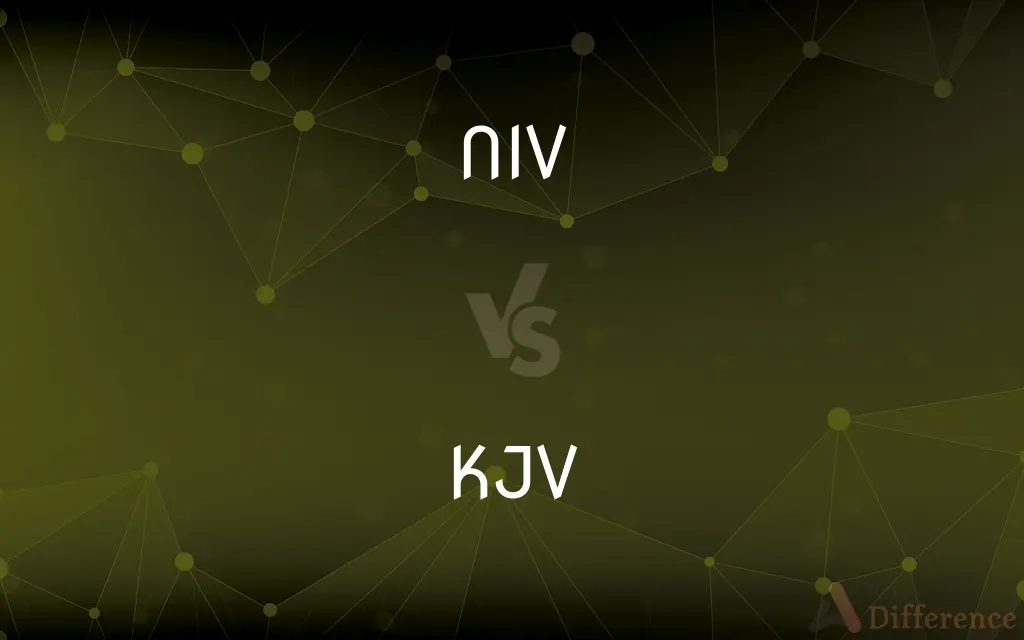NIV vs. KJV — What's the Difference?
By Maham Liaqat & Fiza Rafique — Published on March 3, 2024
The NIV is a modern English translation of the Bible with a balance between word-for-word and thought-for-thought translation techniques. The KJV, a classic English translation from 1611, uses early modern English and a formal equivalence approach.

Difference Between NIV and KJV
Table of Contents
ADVERTISEMENT
Key Differences
The NIV, first published in 1978, aims to offer an accessible translation for contemporary readers, employing a balance between word-for-word accuracy and thought-for-thought clarity. This approach helps in understanding the original biblical texts' meanings in today's language context, making the NIV popular for personal study and worship.
The KJV, authorized by King James I of England, is renowned for its majestic style and poetic rhythm, making it a staple in English literature and religious ceremonies. Its translation strictly follows the formal equivalence method, prioritizing a direct correspondence between the original Hebrew, Greek, and Aramaic texts and early modern English.
The NIV provides readability and accessibility for modern readers, whereas the KJV offers literary beauty and a closer adherence to the original language structure. This difference makes the NIV preferred for everyday reading and study, whereas the KJV is cherished for its literary quality and historical significance.
The translation philosophy differences highlight the NIV's focus on understandability and relevance, contrasting with the KJV's emphasis on maintaining the stylistic and linguistic choices of the original texts. This distinction caters to the diverse preferences of Bible readers, offering options between modern clarity and traditional reverence.
The ongoing debate between supporters of the NIV and the KJV centers on translation accuracy versus readability. Advocates for the NIV appreciate its efforts to make the Bible's messages accessible without extensive historical or linguistic knowledge, while KJV proponents value the preservation of the Bible's historical language and literary form.
ADVERTISEMENT
Comparison Chart
Year of Publication
1978
1611
Translation Philosophy
Balance between word-for-word and thought-for-thought
Formal equivalence (word-for-word)
Language
Contemporary English
Early Modern English
Readability
High, suitable for modern readers
Lower, due to archaic language
Purpose
Accessibility and clarity for contemporary understanding
Preservation of literary and historical qualities
Compare with Definitions
NIV
Popular for study and personal use.
Many churches recommend NIV for daily reading.
KJV
Cherished in traditional worship.
Traditional services often feature readings from the KJV.
NIV
Revised for contemporary language use.
NIV updates ensure relevance to today's readers.
KJV
Prioritizes direct translation.
KJV remains close to the original Hebrew and Greek texts.
NIV
A modern translation for clarity and comprehension.
The NIV makes biblical teachings more accessible.
KJV
Uses early modern English.
KJV's language, though archaic, adds a poetic dimension to scripture reading.
NIV
Focuses on understandability.
NIV's translation philosophy prioritizes clear communication of biblical principles.
KJV
Historical and literary significance.
The KJV has influenced English literature and language profoundly.
NIV
Balances literal and dynamic translation.
NIV's approach captures the meaning behind the original texts.
KJV
Celebrated for its majestic style.
The KJV's poetic rhythm enhances the solemnity of biblical verses.
Common Curiosities
Why was the NIV Bible created?
The NIV was created to provide an accurate, readable, and modern English translation of the Bible.
Is the NIV easier to understand than the KJV?
Yes, the NIV's use of contemporary language makes it more accessible to modern readers.
What makes the KJV unique?
The KJV is unique for its literary quality, historical significance, and use of early modern English.
Can the NIV and KJV be used together?
Yes, using both can provide a deeper understanding by comparing contemporary readability with classic literary style.
Why do some prefer the KJV over newer translations?
Some prefer the KJV for its poetic language, historical authenticity, and perceived adherence to the original texts.
Can children understand the NIV or KJV better?
Children are likely to find the NIV more understandable due to its use of contemporary language.
How often is the NIV updated?
The NIV has been updated several times (most notably in 1984, 2005, and 2011) to reflect contemporary language and scholarship.
What role does the NIV play in modern Christianity?
The NIV serves as a bridge, making the Bible accessible and relevant to contemporary life and spirituality.
How do the NIV and KJV handle cultural and historical context?
The KJV preserves the context of its translation period, while the NIV attempts to translate cultural and historical nuances into modern terms.
Does the KJV include the Apocrypha?
The original 1611 KJV included the Apocrypha, but most modern editions do not.
Which version is better for new Bible readers?
The NIV is often recommended for new readers due to its readability and clear language.
Is the poetic language of the KJV difficult for modern readers?
Yes, the archaic language can be challenging, but many find it enriches the reading experience.
Why might someone choose the KJV for personal study?
Individuals may choose the KJV for its literary beauty, depth of tradition, and the challenge of engaging with its complex language.
Are there significant differences in translation accuracy between the NIV and KJV?
Differences in translation philosophy mean the NIV focuses on clarity and readability, while the KJV emphasizes a direct translation approach, affecting their respective accuracies in different ways.
How do translation philosophies affect Bible study?
Translation philosophy impacts how scripture is interpreted and understood, influencing study depth and accessibility.
Share Your Discovery

Previous Comparison
Micro SDHC vs. Micro SDXC
Next Comparison
Central Government vs. Local GovernmentAuthor Spotlight
Written by
Maham LiaqatCo-written by
Fiza RafiqueFiza Rafique is a skilled content writer at AskDifference.com, where she meticulously refines and enhances written pieces. Drawing from her vast editorial expertise, Fiza ensures clarity, accuracy, and precision in every article. Passionate about language, she continually seeks to elevate the quality of content for readers worldwide.
















































